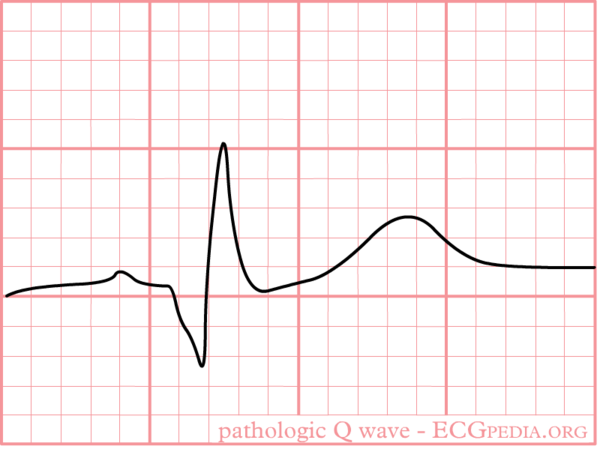Pathologic Q Waves: Difference between revisions
mNo edit summary |
mNo edit summary |
||
| Line 1: | Line 1: | ||
[[Image:PathoQ.png|thumb| A pathologic Q wave]] | [[Image:PathoQ.png|thumb| A pathologic Q wave]] | ||
Pathologic Q waves are a sign of '''previous [[Myocardial Infarction|myocardial infarction]]'''. The are the result of absence of electrical activity. A myocardial infarction can be thought of as an elecrical 'hole' as scar tissue is electrically dead and therefore results in pathologic Q waves. Pathologic Q waves are not an early sign of myocardial infarction, but '''generally take several hours to days to develop'''. | Pathologic Q waves are a sign of '''previous [[Myocardial Infarction|myocardial infarction]]'''. The are the result of absence of electrical activity. A myocardial infarction can be thought of as an elecrical 'hole' as scar tissue is electrically dead and therefore results in pathologic Q waves. Pathologic Q waves are not an early sign of myocardial infarction, but '''generally take several hours to days to develop'''. Once pathologic Q waves have developed they rarely go away. However, if the myocardial infarction is reperfused early (e.g. as a result of percutaneous coronary intervention) stunned myocardial tissue can recover and pathologic Q waves disappear. In all other situations they '''usually persist indefinitely'''. | ||
The precise criteria for pathologic Q waves have been debated. Here we present the latest definition as accepted by the ESC and ACC.<cite>Alpert</cite> | The precise criteria for pathologic Q waves have been debated. Here we present the latest definition as accepted by the ESC and ACC.<cite>Alpert</cite> | ||
Revision as of 17:06, 24 July 2007

Pathologic Q waves are a sign of previous myocardial infarction. The are the result of absence of electrical activity. A myocardial infarction can be thought of as an elecrical 'hole' as scar tissue is electrically dead and therefore results in pathologic Q waves. Pathologic Q waves are not an early sign of myocardial infarction, but generally take several hours to days to develop. Once pathologic Q waves have developed they rarely go away. However, if the myocardial infarction is reperfused early (e.g. as a result of percutaneous coronary intervention) stunned myocardial tissue can recover and pathologic Q waves disappear. In all other situations they usually persist indefinitely.
The precise criteria for pathologic Q waves have been debated. Here we present the latest definition as accepted by the ESC and ACC.Alpert
- Definition of a pathologic Q wave
- Any Q wave in leads V1-V3
- Q wave > or = to 30ms (0.03s) in leads I, II, aVL, aVF, V4, V4, or V6 (the Q wave changes must be present in any two contiguous lead, and be > or = 1mm in depth).
Notes
- Absence of pathologic Q waves does not exclude a myocardial infarction!
- Lead III often shows Q waves, which are not pathologic as long as Q waves are absent in leads II and aVF (the contiguous leads)
For those interested: the Minnesota Code Classification System for Electrocardiographic Findings contains a very extensive definition of pathologic Q waves.
Referenties
<biblio>
- Alpert pmid=10987628
</biblio>